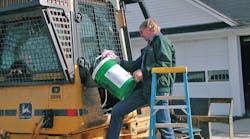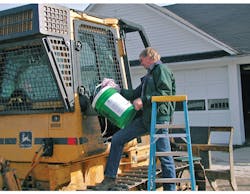This file type includes high resolution graphics and schematics when applicable.
The Hiawatha National Forest is geographically tucked between three of the Great Lakes, within the central to eastern portion of the Upper Peninsula of Michigan. To preserve the 879,000 acres of forest, Hiawatha National Forest Fleet manager W. Toby Rhue partnered with Michigan Soybean Promotion Committee (MSPC) Field Operations Director Keith Reinholt to incorporate bio-based products use at the facility in Michigan.
“I began thinking about how we at Hiawatha could benefit by using these products,” says Rhue. “I coordinate the management of over 200 pieces of transportation equipment. The positive environmental aspect of these products are important to us in the National Forest Service and we knew, being a part of the U.S. Department of Agriculture, that we would eventually need to comply with the Federal preferential purchasing for bio-based products program.”
Rhue began his internal preparations to ensure success in 2006. He conducted a one-day bio-based fuels and lubricant seminar on each side of the Forest. He organized and conducted the seminar with presenters Chris Case, Keith Reinholt and William Gamier of Renewable Lubricants Inc.. In 2007, Rhue met with Forest staff responsible for purchasing supplies, suggested sources for bio-based lubricants and asked individuals planning orders to let others know so that orders could be consolidated. Reinholt suggested that the Hiawatha employees might use even more bio-based products if they were given the right opportunity.
Rhue and Reinholt worked out details of the MSPC complimentary sampling program, “We got the samples and started using them in the summer of 2008,” explains Rhue who points out that, “The people who used the products were the ones that decided whether they’ll be adopted for use in the future based on how well the products perform and particularly their reliability.”
Recreation Technician Brenda Madden is in charge of the maintenance of more than 20 recreation sites and facilities in the Hiawatha National Forest. “All of the products we used work really well. That includes cleaning products, two-cycle engine oil, and bar-and-chain oil, penetrating oil and hand cleaners.”
Forest Heavy Equipment Operator Daryl Ulberg reports similar good results for performance and reliability. “We are using bio-based hydraulic fluids and grease. These products work just as well as the petroleum-based counterparts.”
Rhue says that when the Forest was ready to replace two large log skidders and a grader, they asked bidders’ price quotes to have the equipment delivered ‘with green hydraulic fluid’. “In other words, we wanted it to come using bio-based hydraulic fluid in the transmission and lift cylinders. The winner of those bids, Caterpillar, agreed to these specifications. These were our first pieces of equipment that have come that way. I’m sure it won’t be the last,” he concludes.
This file type includes high resolution graphics and schematics when applicable.



